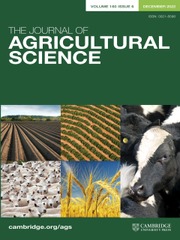Crossref Citations
This article has been cited by the following publications. This list is generated based on data provided by
Crossref.
Elfadl, E.
Reinbrecht, C.
Frick, C.
and
Claupein, W.
2009.
Optimization of nitrogen rate and seed density for safflower (Carthamus tinctorius L.) production under low-input farming conditions in temperate climate.
Field Crops Research,
Vol. 114,
Issue. 1,
p.
2.
Sieling, Klaus
and
Kage, Henning
2010.
Efficient N management using winter oilseed rape. A review.
Agronomy for Sustainable Development,
Vol. 30,
Issue. 2,
p.
271.
Engström, Lena
Stenberg, Maria
Aronsson, Helena
and
Lindén, Börje
2011.
Reducing nitrate leaching after winter oilseed rape and peas in mild and cold winters.
Agronomy for Sustainable Development,
Vol. 31,
Issue. 2,
p.
337.
Sieling, Klaus
and
Kage, Henning
2011.
Sustainable Agriculture Volume 2.
p.
931.
Walters, Dale R.
Paterson, Linda
Sablou, Cecile
and
Walsh, David J.
2011.
Existing infection with Rhynchosporium secalis compromises the ability of barley to express induced resistance.
European Journal of Plant Pathology,
Vol. 130,
Issue. 1,
p.
73.
Kessel, Bettina
Schierholt, Antje
and
Becker, Heiko C.
2012.
Nitrogen Use Efficiency in a Genetically Diverse Set of Winter Oilseed Rape (Brassica napus L.).
Crop Science,
Vol. 52,
Issue. 6,
p.
2546.
ISHIKAWA, S.
HARE, M. C.
and
KETTLEWELL, P. S.
2012.
Effects of strobilurin fungicide programmes and fertilizer nitrogen rates on winter wheat: leaf area, dry matter yield and nitrogen yield.
The Journal of Agricultural Science,
Vol. 150,
Issue. 4,
p.
427.
Salgado, Paulo
Thang, Vu Q.
Thu, Tran V.
Trach, Nguyen X.
Cuong, Vu C.
Lecomte, Philippe
and
Richard, Didier
2013.
Oats (Avena strigosa) as winter forage for dairy cows in Vietnam: an on-farm study.
Tropical Animal Health and Production,
Vol. 45,
Issue. 2,
p.
561.
Stenberg, Maria
Engström, Lena
Wallenhammar, Ann-Charlotte
Gruvaeus, Ingemar
and
Lööf, Pär-Johan
2013.
Nitrogen management strategies in organic winter oilseed rape (Brassica napus L.) production.
Organic Agriculture,
Vol. 3,
Issue. 2,
p.
71.
Ulas, Abdullah
Behrens, Torsten
Wiesler, Franz
Horst, Walter J.
and
Schulte auf’m Erley, Gunda
2013.
Does genotypic variation in nitrogen remobilisation efficiency contribute to nitrogen efficiency of winter oilseed-rape cultivars (Brassica napus L.)?.
Plant and Soil,
Vol. 371,
Issue. 1-2,
p.
463.
Nyikako, John
Schierholt, Antje
Kessel, Bettina
and
Becker, Heiko C.
2014.
Genetic variation in nitrogen uptake and utilization efficiency in a segregating DH population of winter oilseed rape.
Euphytica,
Vol. 199,
Issue. 1-2,
p.
3.
Engström, Lena
Stenberg, Maria
Wallenhammar, Ann-Charlotte
Ståhl, Per
and
Gruvaeus, Ingemar
2014.
Organic winter oilseed rape response to N fertilisation and preceding agroecosystem.
Field Crops Research,
Vol. 167,
Issue. ,
p.
94.
Weymann, Wiebke
Böttcher, Ulf
Sieling, Klaus
and
Kage, Henning
2015.
Effects of weather conditions during different growth phases on yield formation of winter oilseed rape.
Field Crops Research,
Vol. 173,
Issue. ,
p.
41.
Walter, Katja
Don, Axel
Fuß, Roland
Kern, Jürgen
Drewer, Julia
and
Flessa, Heinz
2015.
Direct nitrous oxide emissions from oilseed rape cropping – a meta‐analysis.
GCB Bioenergy,
Vol. 7,
Issue. 6,
p.
1260.
Hoffmann, M.P.
Jacobs, A.
and
Whitbread, A.M.
2015.
Crop modelling based analysis of site-specific production limitations of winter oilseed rape in northern Germany.
Field Crops Research,
Vol. 178,
Issue. ,
p.
49.
Pahlmann, Ingo
Böttcher, Ulf
and
Kage, Henning
2016.
Evaluation of small site-specific N fertilization trials using uniformly shaped response curves.
European Journal of Agronomy,
Vol. 76,
Issue. ,
p.
87.
Miersch, Sebastian
Gertz, Andreas
Breuer, Frank
Schierholt, Antje
and
Becker, Heiko C.
2016.
Influence of the Semi‐dwarf Growth Type on Nitrogen Use Efficiency in Winter Oilseed Rape.
Crop Science,
Vol. 56,
Issue. 6,
p.
2952.
Stahl, Andreas
Friedt, Wolfgang
Wittkop, Benjamin
and
Snowdon, Rod J.
2016.
Complementary diversity for nitrogen uptake and utilisation efficiency reveals broad potential for increased sustainability of oilseed rape production.
Plant and Soil,
Vol. 400,
Issue. 1-2,
p.
245.
Sieling, Klaus
Böttcher, Ulf
and
Kage, Henning
2017.
Effect of Sowing Method and N Application on Seed Yield and N Use Efficiency of Winter Oilseed Rape.
Agronomy,
Vol. 7,
Issue. 1,
p.
21.
Pahlmann, Ingo
Böttcher, Ulf
and
Kage, Henning
2017.
Developing and testing an algorithm for site-specific N fertilization of winter oilseed rape.
Computers and Electronics in Agriculture,
Vol. 136,
Issue. ,
p.
228.

